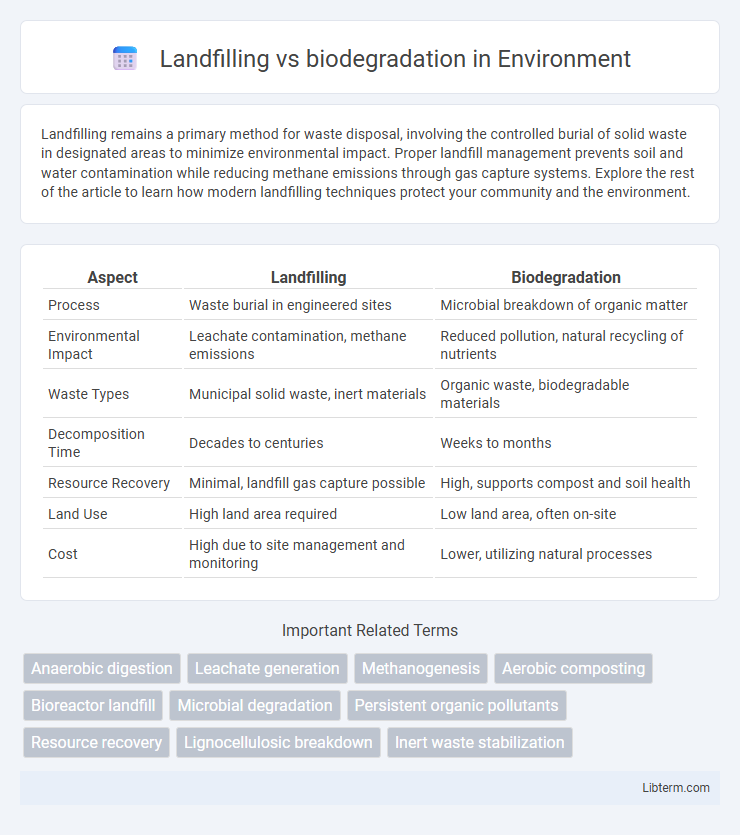Landfilling remains a primary method for waste disposal, involving the controlled burial of solid waste in designated areas to minimize environmental impact. Proper landfill management prevents soil and water contamination while reducing methane emissions through gas capture systems. Explore the rest of the article to learn how modern landfilling techniques protect your community and the environment.
Table of Comparison
| Aspect | Landfilling | Biodegradation |
|---|---|---|
| Process | Waste burial in engineered sites | Microbial breakdown of organic matter |
| Environmental Impact | Leachate contamination, methane emissions | Reduced pollution, natural recycling of nutrients |
| Waste Types | Municipal solid waste, inert materials | Organic waste, biodegradable materials |
| Decomposition Time | Decades to centuries | Weeks to months |
| Resource Recovery | Minimal, landfill gas capture possible | High, supports compost and soil health |
| Land Use | High land area required | Low land area, often on-site |
| Cost | High due to site management and monitoring | Lower, utilizing natural processes |
Introduction to Landfilling and Biodegradation
Landfilling involves the disposal of waste materials by burying them in designated areas, where limited oxygen slows the breakdown process, leading to long-term environmental impacts such as methane gas emissions and groundwater contamination. Biodegradation is the natural breakdown of organic matter by microorganisms, resulting in the conversion of waste into simpler, non-toxic substances like carbon dioxide, water, and biomass. Understanding the differences between landfilling and biodegradation is crucial for developing effective waste management strategies that minimize ecological harm and promote sustainable resource recovery.
Definition and Processes of Landfilling
Landfilling is the controlled disposal of waste in designated sites where materials are compacted and buried to minimize environmental impact. The process involves layering waste with soil to reduce odors, deter pests, and limit exposure to air, which slows down decomposition. Unlike biodegradation, which is the natural breakdown of organic matter by microorganisms, landfilling primarily serves as a method for waste containment rather than waste breakdown.
Understanding Biodegradation: Mechanisms and Types
Biodegradation involves the breakdown of organic materials by microorganisms into simpler substances, primarily carbon dioxide, water, and biomass, through aerobic and anaerobic processes. Aerobic biodegradation occurs in the presence of oxygen, producing carbon dioxide and water, while anaerobic biodegradation takes place without oxygen, generating methane and carbon dioxide. Understanding these mechanisms highlights the environmental advantages of biodegradation over landfilling, which typically leads to long-term waste accumulation and greenhouse gas emissions.
Environmental Impacts of Landfilling
Landfilling generates significant greenhouse gas emissions, primarily methane, contributing to climate change due to anaerobic decomposition of organic waste. Leachate from landfills can contaminate soil and groundwater with hazardous chemicals, posing risks to ecosystems and human health. Landfilling also leads to long-term land use issues and habitat disruption, making waste management practices with lower environmental impacts, like biodegradation, more favorable.
Environmental Advantages of Biodegradation
Biodegradation significantly reduces environmental pollution by breaking down organic waste into harmless natural substances, minimizing methane emissions compared to landfilling. This natural process promotes soil health and nutrient recycling, enhancing ecosystem sustainability. Moreover, biodegradation decreases the volume of waste in landfills, reducing land use and leachate formation risks.
Waste Management Efficiency: Landfilling vs Biodegradation
Landfilling offers immediate containment for waste but often results in long-term environmental risks due to slow decomposition rates and methane emissions. Biodegradation enhances waste management efficiency by accelerating organic matter breakdown through microbial processes, reducing landfill volume and promoting nutrient recycling. Optimizing biodegradation techniques such as composting and anaerobic digestion can significantly improve waste diversion from landfills and lower greenhouse gas outputs.
Greenhouse Gas Emissions Comparison
Landfilling generates significant greenhouse gas emissions, primarily methane, a potent contributor to climate change due to anaerobic decomposition of organic waste. Biodegradation, particularly when managed through aerobic composting, results in lower greenhouse gas emissions by converting waste into carbon dioxide and biomass with minimal methane release. Effective waste management strategies that favor biodegradation over landfilling can substantially reduce the carbon footprint associated with organic waste disposal.
Economic Considerations in Waste Disposal Methods
Landfilling generally entails lower upfront costs but incurs long-term expenses related to land use, methane management, and environmental monitoring, impacting overall economic feasibility. Biodegradation methods, such as composting and anaerobic digestion, often require higher initial investments in technology and infrastructure but can generate economic returns through biogas production and nutrient-rich soil amendments. Evaluating waste disposal methods economically involves balancing immediate operational costs against potential revenue streams and environmental compliance savings.
Long-Term Sustainability: Landfills versus Biodegradation
Landfilling traps organic waste in anaerobic conditions, leading to slow decomposition and long-term methane emissions that contribute to greenhouse gases. Biodegradation, particularly through composting or bio-reactors, accelerates organic matter breakdown, reducing landfill volume and producing nutrient-rich soil amendments. Sustainable waste management favors biodegradation over landfilling to minimize environmental impact and support circular economy principles.
Future Trends and Innovations in Waste Management
Future trends in waste management prioritize enhancing biodegradation technologies to reduce landfill reliance and mitigate environmental impact. Innovations include engineered microbial consortia and advanced enzymatic processes that accelerate organic waste breakdown, coupled with integrated waste-to-energy systems improving resource recovery. Emerging policies incentivize circular economy models, promoting landfill diversion through sustainable packaging and composting infrastructure expansion.
Landfilling Infographic

 libterm.com
libterm.com